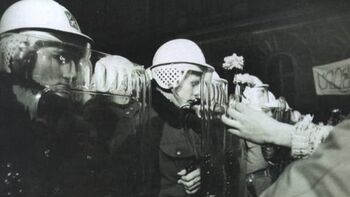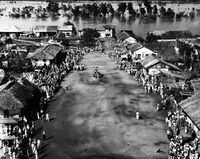Asterian Spring: Difference between revisions
No edit summary |
|||
| Line 53: | Line 53: | ||
===Gapolania=== | ===Gapolania=== | ||
[[File:Guillermo_Rodriguez_(Ecuador).jpg|thumb|200px|Eugenio Giovanardi was acting as a Gapolanese head of state between 1966 and 1977.]] | |||
The Gapolanese military seized power in the country following the coup in 1966 and introduced the [[National Restoration]] (''Restauro Nazionale''), establishing a military dictatorship led primarily by [[Eugenio Giovanardi]]. Giovanardi's mission was to revert the changes made by socialist leaning former president, Augusto Norta, resulting in a deep economic crisis. The National Restoration was initially thought to act as a transitional period that would create a way for new elections in 1967 or 1968, yet the junta lasted until 1981, using well-executed propaganda and {{wp|neoliberalism|neoliberal}} economic reforms to stay in power. | |||
Giovanardi's dictatorship was characterized by an intense political oppression, mostly against left-wing parties and politicians. The military was tasked with fighting the {{wp|guerilla warfare|guerillas}} hidden in the nation's interior - this resulted in a terror and antagonization of the local rural populations, often favoring and supporting socialist groups. It's estimated that between 1966 and 1975, nearly 5000 people were killed, with another 2 to 3 thousand exiled or missing. During the initial years, a curfew was introduced and a right to social gatherings was harshly tightened. Political opposition was surveilled and most already existing parties were either disbanded or banned. | |||
Following the recommendation of several economists, the National Restoration implemented a wide set of economic reforms, focusing on {{wp|free market}}, {{wp|fiscal conservatism|fiscally conservative}} and neoliberal economy. The main Gapolanese industries: {{wp|banana industry|banana cultivation}}, {{wp|citrus production|citrus cultivation}}, {{wp|oil production}} and {{wp|mining|copper mining}} were de-nationalized and opened to private investments, with mediocre success. The government also decided to introduce a fixed exchange rate, leading to a surge in exports and imports, though a significant import surplus and a collapse of domestic production led to a crisis, with GDP decreasing by nearly 15% in 1971 and unemployment reaching over 25% the same year. | |||
[[File:Hurricane_Gapolania.jpg|thumb|left|200px|The hurricane of 1973 was one of the deadliest disasters in Gapolanese hitory.]] | |||
In 1973, Gapolania was devastated by one of the strongest {{wp|hurricane|hurricanes}} in the nation's history: the disaster affected mostly the eastern part of the country, a major crop producing region. The capital, [[Nassea]], was {{wp|flood|flooded}}, together with several other major cities. The agriculture production decreased by over 80% and state-wide repairs and rebuilds of infrastructure caused the government to get into massive external debt. Many citizens were forced to assist in the reconstruction works and some needed to change professions in order to meet a growing demand on food, pharmaceuticals, clothing and building materials. {{wp|Organized crime}} groups, [[Elenditi]], reached prominence during these years, offering first need items, smuggling food and people in exchange for money or work. | |||
Continuous economic collapse resulted in a meltdown of the financial sector. Nearly one third of the financial institutions faced {{wp|bankruptcy}}. In 1974, four major banks were nationalized and another two a year later. The central bank took over foreign debts, destabilizing the currency. Rising inflation resulted in a devaluation of ''moneta'', causing a massive uproar within the middle and upper classes, on which the military junta was relying. While the protests were quickly prevented before gaining momentum, Giovanardi stepped down as the president. The public calls for elections were disbanded, with the junta explaining the National Restoration had not ended yet and that the elections were unnecessary expense. To calm the population, the junta installed [[Marco Furigioni]], the leader of the centre-right [[Supportist Party]], as an acting president. Realistically, Furigioni had little to no power and most of the decisions were still made by the military. | |||
Efforts to stimulate the market and further privatize economy were not as successful as the government expected. By 1978, the average income had risen only by 10%, compared to the levels of late 1960s and the gap between high and low income households doubled. Unemployment was still high, especially within the youth and women, while privatized higher education facilities proved to be unaffordable to the citizens. The {{wp|net migration rate}} was one of the lowest in the world and a {{wp|black market}} share was continuously increasing, consuming labor force and the national GDP. | |||
A serious cut in social benefits and pensions in late 1980 caused people to go on the streets. Despite the military presence and a limited right to social gatherings, left-wing politicians rallied people to the city centers, announcing a general protest. On 17th February 1981 the people went on the streets of [[Zeta]], marking the beginning of the [[Hibiscus Revolution]]. | |||
===Jossia=== | ===Jossia=== | ||
Revision as of 16:39, 19 January 2021
| Asterian Spring | |
|---|---|
 Gapolanese State Police during the Hibiscus Revolution, Gapolania | |
| Date | 1973-1983 |
| Location | |
| Caused by | Authoritarianism corruption Human rights violations |
| Goals | Democracy Free elections regime change |
| Methods | Civil disobedience Civil resistance Insurgency Protests Revolution Riots Uprising |
| Resulted in | Full Result by country
|
The Asterian Spring was a period of protests, reveloutions and democratization that saw many right-wing and authoritarian governments collapse across Asteria Inferior and the Arucian. It is widely accepted that the period began in 1973 during the 1973 Satavian Riots, and ended in 1983 following the end of the Satavian Crisis. Notable events included the collapse of the National Government of Satavia in 1976 and the ensuing Satavian Crisis, the Velvet Revolution in Aucuria, the election of left-wing Félix Bragança in Belmonte, the Azzurri Revolution in Jossia, and the Hibiscus Revolution in Gapolania.
Causes
Aucuria
Belmonte
Gapolania
The Gapolanese military seized power in the country following the coup in 1966 and introduced the National Restoration (Restauro Nazionale), establishing a military dictatorship led primarily by Eugenio Giovanardi. Giovanardi's mission was to revert the changes made by socialist leaning former president, Augusto Norta, resulting in a deep economic crisis. The National Restoration was initially thought to act as a transitional period that would create a way for new elections in 1967 or 1968, yet the junta lasted until 1981, using well-executed propaganda and neoliberal economic reforms to stay in power.
Giovanardi's dictatorship was characterized by an intense political oppression, mostly against left-wing parties and politicians. The military was tasked with fighting the guerillas hidden in the nation's interior - this resulted in a terror and antagonization of the local rural populations, often favoring and supporting socialist groups. It's estimated that between 1966 and 1975, nearly 5000 people were killed, with another 2 to 3 thousand exiled or missing. During the initial years, a curfew was introduced and a right to social gatherings was harshly tightened. Political opposition was surveilled and most already existing parties were either disbanded or banned.
Following the recommendation of several economists, the National Restoration implemented a wide set of economic reforms, focusing on free market, fiscally conservative and neoliberal economy. The main Gapolanese industries: banana cultivation, citrus cultivation, oil production and copper mining were de-nationalized and opened to private investments, with mediocre success. The government also decided to introduce a fixed exchange rate, leading to a surge in exports and imports, though a significant import surplus and a collapse of domestic production led to a crisis, with GDP decreasing by nearly 15% in 1971 and unemployment reaching over 25% the same year.
In 1973, Gapolania was devastated by one of the strongest hurricanes in the nation's history: the disaster affected mostly the eastern part of the country, a major crop producing region. The capital, Nassea, was flooded, together with several other major cities. The agriculture production decreased by over 80% and state-wide repairs and rebuilds of infrastructure caused the government to get into massive external debt. Many citizens were forced to assist in the reconstruction works and some needed to change professions in order to meet a growing demand on food, pharmaceuticals, clothing and building materials. Organized crime groups, Elenditi, reached prominence during these years, offering first need items, smuggling food and people in exchange for money or work.
Continuous economic collapse resulted in a meltdown of the financial sector. Nearly one third of the financial institutions faced bankruptcy. In 1974, four major banks were nationalized and another two a year later. The central bank took over foreign debts, destabilizing the currency. Rising inflation resulted in a devaluation of moneta, causing a massive uproar within the middle and upper classes, on which the military junta was relying. While the protests were quickly prevented before gaining momentum, Giovanardi stepped down as the president. The public calls for elections were disbanded, with the junta explaining the National Restoration had not ended yet and that the elections were unnecessary expense. To calm the population, the junta installed Marco Furigioni, the leader of the centre-right Supportist Party, as an acting president. Realistically, Furigioni had little to no power and most of the decisions were still made by the military.
Efforts to stimulate the market and further privatize economy were not as successful as the government expected. By 1978, the average income had risen only by 10%, compared to the levels of late 1960s and the gap between high and low income households doubled. Unemployment was still high, especially within the youth and women, while privatized higher education facilities proved to be unaffordable to the citizens. The net migration rate was one of the lowest in the world and a black market share was continuously increasing, consuming labor force and the national GDP.
A serious cut in social benefits and pensions in late 1980 caused people to go on the streets. Despite the military presence and a limited right to social gatherings, left-wing politicians rallied people to the city centers, announcing a general protest. On 17th February 1981 the people went on the streets of Zeta, marking the beginning of the Hibiscus Revolution.
Jossia
Nuvania
Satavia
Timeline
Summary of conflicts by country
Aucuria


